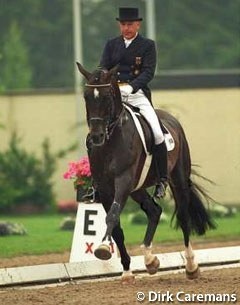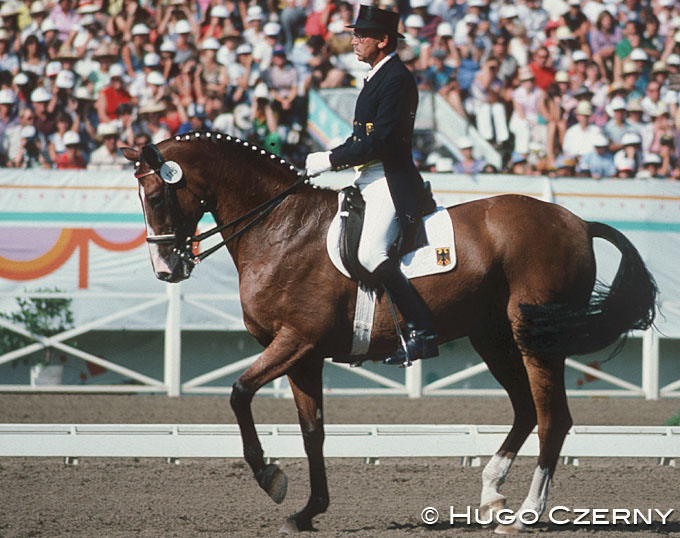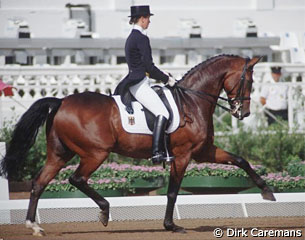
In July 1995, the late American dressage trainer Susan Hayes Woods interviewed the late Dr. Reiner Klimke at the CHIO Aachen. This edited interview from 1995 is a poignant reminder that modern dressage started to go wrong over 20 years ago...
SUSAN’S INTERVIEW WITH DR. REINER KLIMKE AT THE AACHEN CHIO JULY 1995
Susan: I was watching you as you schooled Biotop in the indoor arena this morning, and it was wonderful. I noticed you were working him in a fat snaffle, and I wondered if you could talk about the importance of working in the snaffle for upper level horses.
Klimke: I ride at home only once a week on the double bridle.
Susan: Do you mean for most of your Grand Prix horses, or for this one especially?
Klimke: All. I want to have them very light in my hand. It is easier when they are really “through”, and they take the bit and take your hands. Then they are not afraid to come out to the double bridle.
Susan: Biotop seems to be very “out” to the bridle–there is not a lot of overflexing.
Klimke: And when he goes in extensions, the neck and frame extend too. And yet there are horses who make their extensions with overflexed necks and they score just as well…
Susan: Can you explain that?
Klimke: Well, when I tell you this, I don’t want to sound jealous, but I live for classical riding. Classical riding means that the horse must go: that is, the energy must come through and the horse reaches forward. But the judges don’t always mark accordingly. I don’t mind; I know what is right. I have been in this sport for nearly 40 years.
Susan: I also saw today that you were doing a lot of work on the basic paces, and simple transitions.
Klimke: Yes. The horse must go forward and he must be happy. If the horse is happy and he trusts you, then you can teach him. If you punish him, that is wrong.
Susan: They never forget. Is there any place for punishment in riding?

Susan: Why does it happen? A lot of these riders will teach and talk about riding classically, and mean to do it, but then it is different here. Is it the pressure?
Klimke: I think everybody wants to win. Perhaps they think if they make a horse tired it will be submissive. Sometimes it may work, but if you really look you can see what is wrong. Some judges don’t have a really good eye, and they judge by punishing mistakes, like too many or too few strides in a pirouette, for example.
Susan: Too much counting and not enough…
Klimke: Yes. The principle is: how is the walk, how is the trot, how is the canter, how is the acceptance of the bridle, how does the back work–all of these things. And in addition, the figures. But they deduct too much if a figure is not 100% okay. You see? If you make a pirouette and the horse really uses his hindquarters, and maybe the pirouette is a little big, you should not be given a 5.
Susan: That’s a little extreme.
Klimke: Yes. It can be at least a 6, can also be a 7, when the horse really canters classically. Even if the circle was too large, remember that you must deduct from 10. The judge must be able to see the main achievement of a horse and rider, in a movement.
Susan: This brings up another question, and that is– there are some amazing equine athletes here, and some of them get a lot of points because of that. Where are the places in the Grand Prix test where the talent can’t cover up the problems with the training?
Klimke: I look only at the way that the horse moves, in all three gaits. He must come from behind, with a swinging back. The head and neck must seek the bit. I hate it if the horse comes behind the vertical and stays there. When the horse is really “through”, you must be able to open and close the frame, and keep him reaching into the bit. And right now, in the judging, in my opinion, this doesn’t count for enough. But sooner or later, good riding will be rewarded. You must not lose your patience, you see. And don’t give up.
Susan: I know that an international horse must have talent for piaffe and passage. At what point in a horse’s life can you tell if that talent is there? Can you tell at the very beginning of training?
Klimke: No. But when you can easily do transitions with the horse–when he shows the ability to sit back–and the half halts go through, I like to see that. And there must be the desire to do the piaffe.
Susan: Whose riding do you admire?
Klimke: Right now?
Susan: Past or present–anybody.

Susan: Do you allow people to watch you school your horses at home?
Klimke: Absolutely. I have nothing to hide. I have seen riders make a fuss about spectators being allowed to watch the schooling at the World Cup Finals. This is wrong. The best thing for the horse is the open door.
Susan: What’s wonderful is that you have demonstrated that classical riding can win.
Klimke: And I will not stay away from it.
Susan: Do you have any special advice for American riders?
Klimke: American riders looked pretty good at the L.A. World Cup Finals. That was a real demonstration to see how you should do it. And there is Michelle Gibson–she rides very well. And she is on the right track. Dover is a very good rider. Since Barcelona, America seems to be on the right track. Only you must continue correctly, and not get confused. America has a chance to win the bronze medal in Atlanta–and I hope they do.
- by Susan Hayes Woods
Reproduced with kind permission of Concordia Equestrians and Bill Woods
Photos © Dirk Caremans - Hugo Czerny - NO REPRODUCTION ALLOWED
Related Links
Eurodressage Photo Database: Reiner Klimke
Dr. Reiner Klimke's Ahlerich
Rider in the Spotlight: Dr. Reiner Klimke
With Dr. Reiner Klimke's Death Germany loses a Great One
Greatest Oldies: Mehmed, Triumph of Training